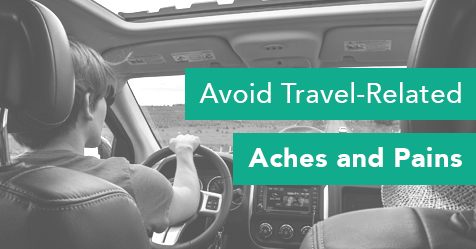Avoid Travel-Related Aches and Pains
by: Sarah Busenitz
Whether your journey is five miles or 5,000, aches and pains could be an unwelcome travel companion. Here are some tips to help your body survive the adventure:
Nutrition:
Our bodies are incredibly adaptive; however, traveling gets us out of our normal routines of nutritional intake and physical activity. It is easy to eat more salty and dehydrating foods such as fast food, chips and coffee when traveling while drinking less than we typically do to reduce the need for sometimes inconvenient bathroom breaks.
But this sets us up for pain. Dehydration is a large contributor to aches as our bodies require a fair amount water to function effectively, from blood flow to muscle activity to joint hydration. Plan for bathroom breaks and give your body a fighting chance.
Movement
The body loves movement for many reasons, including improved blood flow and joint nutrition. When sitting for a prolonged amount of time, you should change positions every 30 minutes. It’s a good idea to stand, lean forward or shift sideways for a minute or two.
If you are standing for a while, change weight from one leg to another, lean against a wall, squat or sit down periodically. If you have a large bag and are in a safe location, place it on the ground at your feet so your body has less weight to carry.
Moving your ankles up and down while seated or rising onto your toes when standing will engage your leg muscles. This will help pump blood to your heart and prevent pain and discomfort from swelling. Backward shoulder rolls are great to help decrease tension in the neck, shoulders, and the whole body.
Posture
Stress and pressure on tissue and nerves changes depending on posture. Our low backs should have a small hollow in it. When we slouch, that natural curve is lost, placing higher stress on supporting tissues and leading to pain.
I’m lazy and can not keep the neutral curve on my own for long periods of time, so I use a lumbar roll/ small pillow/ hoodie… in the small of my back. Hint, make sure your hips are all the way back in the your chair.
After traveling, don’t just sit down for a few minutes: give your spine a break and lie on your back with your knees bent or your feet elevated. This is a decompression position that alleviates pressure and restores nutrients to your spine. It’s also a great position for a cat nap.
Try not to let your head jut forward while driving, sitting, reading, texting. Pull your chin back as if it were sliding on a shelf. Maintaining a more neutral neck position can help avoid tension in the shoulders and neck and even prevent some types of headaches.
Luggage
Your body has to move the bags, so pack smart and light.
- For a purse that goes on one shoulder, keep it to the essentials.
- For a backpack, put the heaviest items closest to the back so it is close to your body’s own weight. Use both straps to even the forces on your spine and a waist strap if the bag has one.
- For suitcases, place heavy items on the bottom for balance when wheeling the case.
Use your legs when lifting bags and avoid twisting at the waist while holding/lifting your bag as this motion creates the greatest forces on your spine.
Earplugs are a helpful item to pack if you are traveling with any engine noise. You will be surprised at how much fatigue and brain pain decrease when you wear them.

